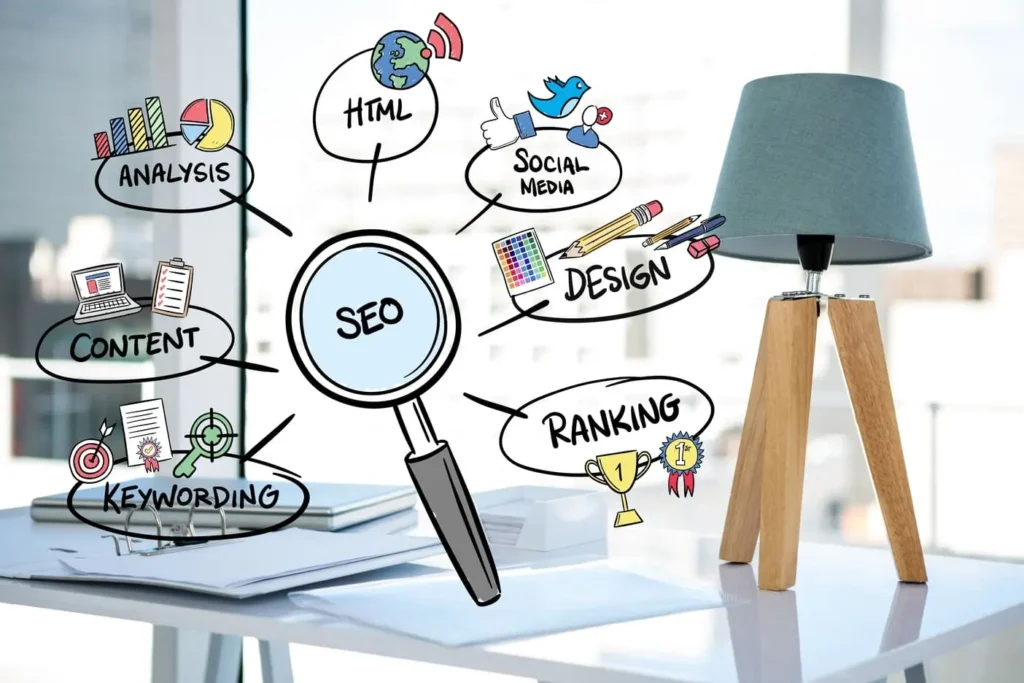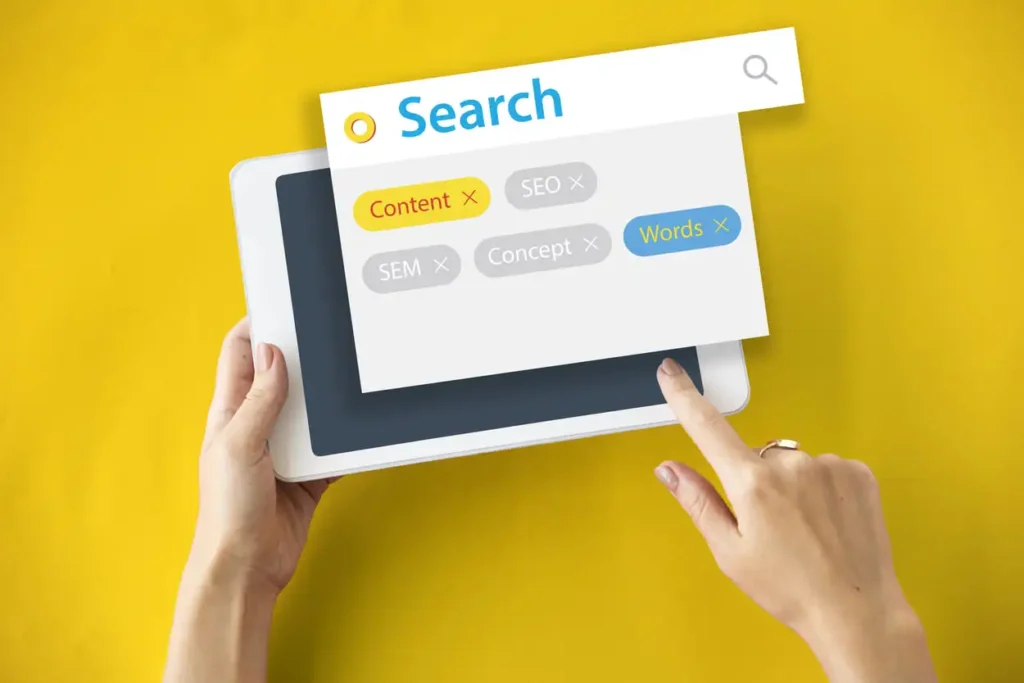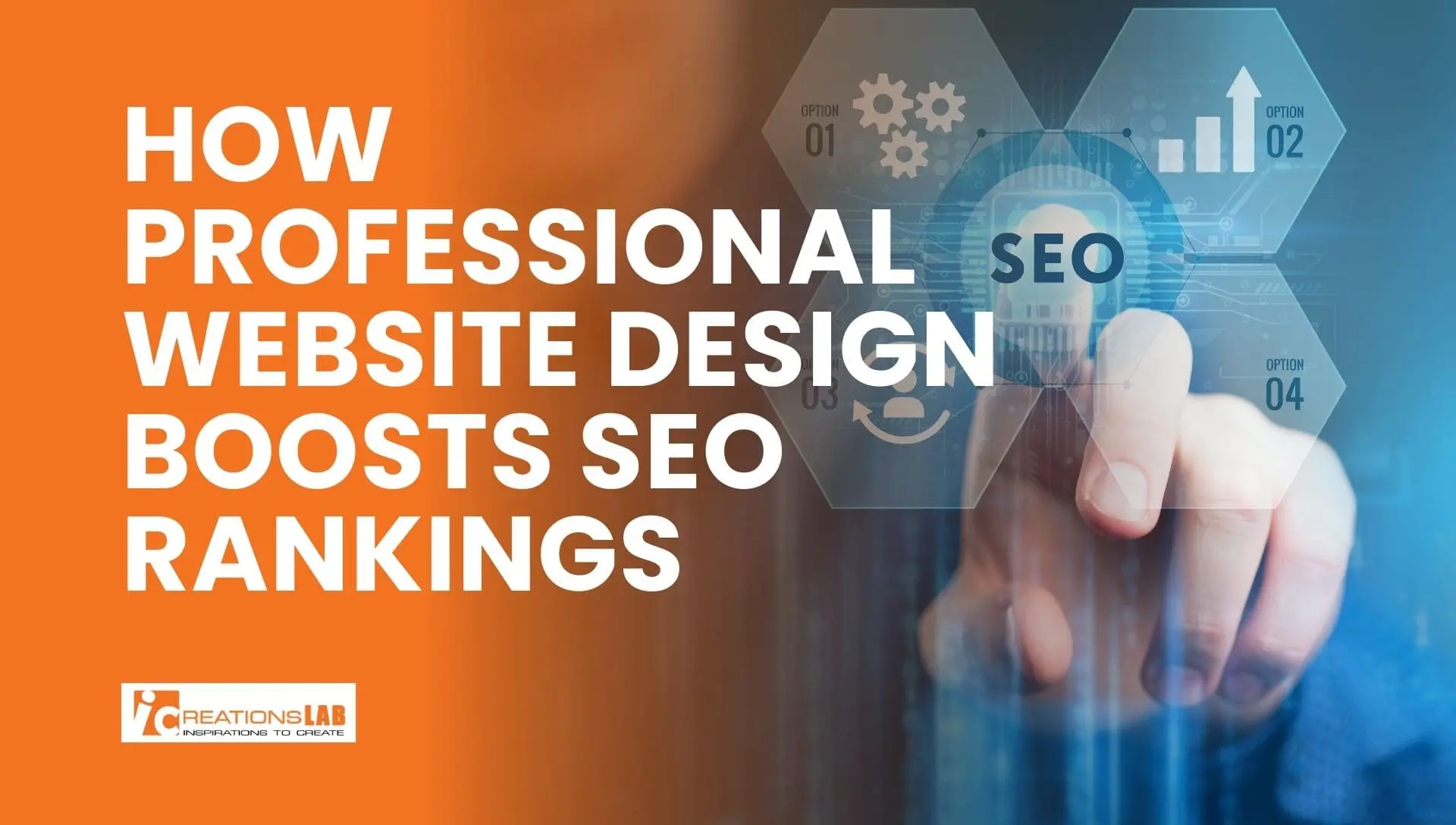How Professional Website Design Impacts SEO Rankings
In today’s competitive digital space, having a beautiful website isn’t enough — it must also be built with search engine optimization (SEO) in mind. Many businesses underestimate the powerful connection between professional website design and their Google rankings, focusing solely on keywords and backlinks.
The truth is, design and SEO are inseparable. A well-designed website not only improves the user experience (UX) but also sends strong positive signals to search engines, resulting in higher visibility, more traffic, and better conversion rates.
In this guide, we’ll explore:
- Why website design is critical to SEO success
- Key design elements that directly affect rankings
- Real-world examples of design changes boosting SEO
- How to plan a design that Google loves
- Mistakes to avoid
See More: How to Get Your Content to Appear in Google’s AI Overview 2025
Why Website Design Matters for SEO
Professional website design isn’t just about looks — it’s about performance, structure, and usability. Google’s ranking algorithms take into account hundreds of signals, and many of them are influenced by how your website is designed.
Here’s why:
- First impressions affect bounce rate – If your website looks outdated or unprofessional, users leave quickly, which tells Google the page isn’t relevant.
- Navigation impacts crawlability – A well-structured site helps search engines index your pages efficiently.
- Mobile-first indexing – Since 2019, Google primarily uses the mobile version of a site for ranking and indexing.
- Core Web Vitals – Page speed, interactivity, and visual stability are all measured by Google as ranking factors, and these are tied to design choices.
In other words, your website’s design can make or break your SEO efforts.
Core Web Design Elements That Influence SEO Rankings
Your website’s design is more than just “looking good” — it’s a critical factor in how search engines rank your site. Below, we’ll explore key design elements that directly affect your SEO performance and why they matter.
1) Mobile Responsiveness – Designing for Every Device

Why it matters: More than 65% of all internet traffic now comes from smartphones and tablets. If your website isn’t mobile-friendly, you’re ignoring the majority of your visitors.
SEO impact: Google uses mobile-first indexing, meaning it primarily crawls and ranks the mobile version of your site. Poor mobile design can drastically hurt your rankings, even if your desktop version looks perfect.
Best practices:
- Use responsive frameworks like Bootstrap or Tailwind CSS.
- Test your site with Google’s Mobile-Friendly Test tool.
- Ensure all content, buttons, and forms are easy to view and interact with on smaller screens.
2) Website Speed – The Need for Instant Gratification

Why it matters: Users expect websites to load in under 3 seconds. A delay of just one second can reduce conversions by 7% and increase bounce rates.
SEO impact: Google’s Core Web Vitals include loading speed as a ranking factor. A slow site signals poor UX, lowering your position in SERPs.
Best practices:
- Compress images using tools like TinyPNG or WebP format.
- Minimize JavaScript and CSS files.
- Choose a fast hosting provider with a CDN (Content Delivery Network).
- Regularly test speed with Google PageSpeed Insights.
3) User-Friendly Navigation – Guiding Visitors and Search Engines
Why it matters: Confusing menus frustrate users, making them leave quickly — a behavior search engines interpret as dissatisfaction.
SEO impact: Well-structured navigation helps Google’s crawlers discover and index all your important pages.
Best practices:
- Keep your main menu simple and clear, with no more than 6–7 top-level items.
- Use breadcrumb navigation for easier backtracking.
- Create internal links between related pages to strengthen topical relevance.
4) Visual Hierarchy – Structuring Content for Maximum Impact
Why it matters: Visitors tend to scan, not read, so your design must guide their eyes to key information.
SEO impact: Proper heading hierarchy (H1 for page title, H2 for subtopics, H3 for details) helps Google understand content structure and relevance.
Best practices:
- Use larger fonts and bold colors for critical CTAs (Calls-To-Action).
- Break content into digestible sections with headings.
- Maintain consistent spacing to avoid visual clutter.
5) On-Page SEO Integration – Building SEO Into the Design Process

Why it matters: Many websites add SEO elements as an afterthought, but integrating them from the start ensures better rankings.
SEO impact: Well-placed keywords in titles, headings, and alt tags signal topic relevance to Google.
Best practices:
- Add title tags and meta descriptions for every page.
- Use keyword-rich headings naturally within content.
- Ensure images have descriptive alt text for accessibility and SEO.
6) Content Layout – Engaging Visitors to Boost Dwell Time
Why it matters: Walls of text overwhelm readers, while clean layouts keep them engaged.
SEO impact: Longer session durations and lower bounce rates are positive signals to Google.
Best practices:
- Use short paragraphs and bullet points.
- Add supporting visuals like images, infographics, and videos.
- Highlight key takeaways with bold text or boxes.
7) Accessibility – Designing for Everyone
Why it matters: An inclusive website ensures all users, including those with disabilities, can interact with your content.
SEO impact: Accessibility improvements like descriptive alt text and proper heading tags also help search engines interpret your site better.
Best practices:
- Ensure keyboard navigation works across all pages.
- Use high-contrast color schemes for readability.
- Add captions or transcripts for multimedia content.
How Google Evaluates Website Design for SEO

Google’s search algorithms have evolved far beyond simple keyword matching — today, they focus heavily on user experience (UX) signals. That means your website’s design is a critical factor in determining your search engine rankings.
Algorithms That Assess Design Quality
Two major systems play a big role:
- RankBrain – Google’s AI-driven algorithm that interprets user behavior to decide if your page is satisfying search intent.
- Page Experience Update – Measures how pleasant and efficient a page is to use, based on both mobile and desktop performance.
Key User Interaction Metrics Google Monitors
1, Bounce Rate – If visitors leave your site quickly without interacting, Google may assume your content or layout isn’t relevant.
2, Average Session Duration – Longer session times indicate that users find your content and design engaging.
3, Pages Per Session – A clear, intuitive navigation can encourage visitors to explore multiple pages.
4, Core Web Vitals –
- LCP (Largest Contentful Paint) – Measures loading speed for your main content.
- FID (First Input Delay) – Tracks how quickly your site responds to a user’s first interaction.
- CLS (Cumulative Layout Shift) – Checks if elements move around unexpectedly during loading, which frustrates users.
Why Design Matters in Google’s Eyes
If your website design:
- Loads quickly
- Displays perfectly on mobile devices
- Offers intuitive navigation and clear visual hierarchy
- Encourages clicks, scrolls, and page visits
… then Google’s algorithms will interpret these behaviors as signals that your site is valuable, trustworthy, and relevant to searchers. Over time, this can lead to higher rankings, more organic traffic, and better conversion rates.
See More: Customised Web Applications to Streamline Your Business
Real-World Example: How Design Changes Boosted SEO
Case Study – E-commerce Fashion Brand in Singapore
A well-known fashion retailer in Singapore faced a serious digital challenge:
- Their website was slow to load, taking an average of 6 seconds.
- The layout was cluttered, making it hard for customers to find products.
- The site was not mobile-friendly, which alienated a growing segment of mobile shoppers.
These issues weren’t just hurting user experience — they were damaging SEO rankings and costing the brand sales.
The Solution: A Complete Professional Redesign
Our design and development approach focused on speed, usability, and mobile-first performance:
1, Mobile-Responsive Redesign
Created layouts that adapt perfectly to any screen size.
Ensured tap-friendly buttons and menus for easy navigation on smartphones.
2, Image Optimization
Compressed high-resolution product images without losing quality.
Implemented next-gen formats like WebP for faster load times.
3, Simplified Navigation
Introduced a clear product categorization system.
Reduced the number of clicks needed to reach a product page.
4, Performance Improvements
Used caching and a content delivery network (CDN) to serve content faster.
Minimized unnecessary code and scripts that slowed the site.
The Results: Quantifiable SEO & Revenue Gains
- Page Load Time: Reduced from 6 seconds → 2.2 seconds.
- Mobile Bounce Rate: Dropped by 38% (fewer visitors leaving immediately).
- Organic Traffic: Increased by 62% in just 3 months.
- Revenue Impact: Higher rankings and better UX led to more sales and repeat customers.
Key Takeaways for Businesses
- Speed is SEO’s silent ranking factor. A slow site frustrates users and lowers rankings.
- Mobile-first design is no longer optional. Over half of e-commerce traffic in Singapore comes from mobile devices.
- Simpler design = higher conversions. Clean navigation keeps visitors engaged and moving toward checkout.
This case study proves that professional web design is not just about looks — it’s a strategic SEO tool that can directly translate into higher visibility, better engagement, and measurable revenue growth.
Planning a Website That Google Loves

A beautiful website means nothing if Google doesn’t understand it or rank it well.
The smartest approach is to design with SEO in mind from the very beginning — not as an afterthought.
Here’s a step-by-step blueprint to ensure your website’s design actively supports SEO success.
1, Start with SEO in Mind
- Treat SEO as part of the design strategy, not a separate task.
- Conduct keyword research before you design layouts, so key pages target the right search intent.
- Plan content blocks where keywords and headings will naturally fit without keyword stuffing.
2, Choose an SEO-Friendly CMS
- Recommended platforms: WordPress (flexible, plugin-rich), Shopify (great for e-commerce), or a custom CMS with clean, lightweight code.
- Avoid website builders that limit URL structures, metadata customization, or site speed optimization.
3, Prioritize Mobile User Experience (UX)
- Mobile-first design is a ranking factor since Google uses mobile-first indexing.
- Test your website on multiple devices, screen sizes, and operating systems before launch.
- Ensure clickable elements are finger-friendly and that no text or images are cut off.
4, Use a Logical Site Architecture
- Group related pages under clear categories for better crawlability.
- Keep your site’s URL structure clean and descriptive (e.g., /services/web-design instead of /page?id=123).
- Include breadcrumb navigation so both users and search engines can understand your site hierarchy.
5, Optimize All Media
- Compress images to reduce file size without sacrificing quality.
- Use lazy loading so media loads only when it appears on screen.
- Always add descriptive alt text with keywords where relevant — it helps with accessibility and image search rankings.
6, Leverage Schema Markup
- Use structured data (Schema.org) to help Google better understand your content type — whether it’s a product, article, review, or FAQ.
- This can increase your chances of appearing in rich snippets and featured results.
7, Test Speed Regularly
- Use tools like Google PageSpeed Insights, GTmetrix, or Lighthouse to measure performance.
- Continuously refine caching, minification, and server response time.
- Remember: even a 0.5 second improvement in load time can significantly reduce bounce rate and improve rankings.
See More: Best Website Development Agencies in Singapore 2025
Mistakes to Avoid When Designing for SEO
Even the most visually stunning website can fail in search rankings if it’s built with the wrong priorities. Avoid these common mistakes that could harm both user experience and Google visibility:
1, Overloading with Animations
- While animations can add flair, too many of them slow down your site and frustrate visitors.
- Heavy animations increase load times — a critical ranking factor.
- Instead, use subtle animations that enhance navigation without sacrificing performance.
2, Ignoring Mobile Optimization
- In 2025 and beyond, mobile-first indexing means Google evaluates your site’s mobile version first.
- If your mobile experience is clunky, slow, or missing elements, your rankings will suffer.
- Prioritize responsive design so your site looks and works perfectly on all devices.
3, Using Too Many Pop-Ups
- Pop-ups can be effective for lead generation, but excessive or poorly timed ones annoy users.
- Google’s Intrusive Interstitials policy may penalize sites with disruptive pop-ups, especially on mobile.
- If you must use them, keep them small, relevant, and easy to close.
4, Not Updating Content
- A beautiful website without fresh, relevant content will quickly lose SEO power.
- Google favors sites that regularly publish updated, high-quality information.
- Maintain a content plan to add new articles, update old posts, and refresh key landing pages.
See More: Best Professional Web Design Services in Singapore
Long-Term Benefits of Professional Web Design for SEO
A professional website design isn’t just about making your site look good today — it’s about creating a sustainable foundation for growth. When done right, it continues to deliver SEO and business benefits for years.
1, Higher Conversion Rates
- A visually appealing, easy-to-navigate site builds user confidence and encourages action.
- Clear calls-to-action (CTAs), intuitive layouts, and fast loading times reduce friction in the customer journey.
- Whether your goal is sales, sign-ups, or inquiries, better UX directly translates into higher conversions.
2, Lower Marketing Costs
- Ranking well in organic search means you rely less on expensive paid advertising campaigns.
- Once your site gains strong SEO traction, you can maintain visibility with minimal ongoing ad spend.
- This frees up budget to reinvest in other growth areas like product development or content marketing.
3, Better Brand Perception
- Your website is often the first impression a potential customer has of your business.
- A clean, modern design conveys trustworthiness, credibility, and professionalism.
- Over time, this positive brand image strengthens customer loyalty and increases referrals.
4, Scalability for Future Growth
- A well-structured, modern site is easier to expand with new products, services, or content without disrupting SEO.
- Flexible frameworks and SEO-friendly CMS platforms make it simple to adapt as technology and market trends evolve.
- You future-proof your business by ensuring your site remains competitive in the long term.
Final Thoughts
Professional website design is one of the most powerful yet overlooked SEO tools. It shapes how users interact with your site, how search engines crawl it, and ultimately, how well you rank.
If you’re serious about climbing Google’s rankings, start by evaluating your design — it might be the missing link in your SEO strategy.
At iCreationsLab, we combine design, SEO, and performance optimization to build websites that don’t just look great but also rank and convert.
See More: Best Ecommerce Website Design Company Singapore – 2025 Guide

